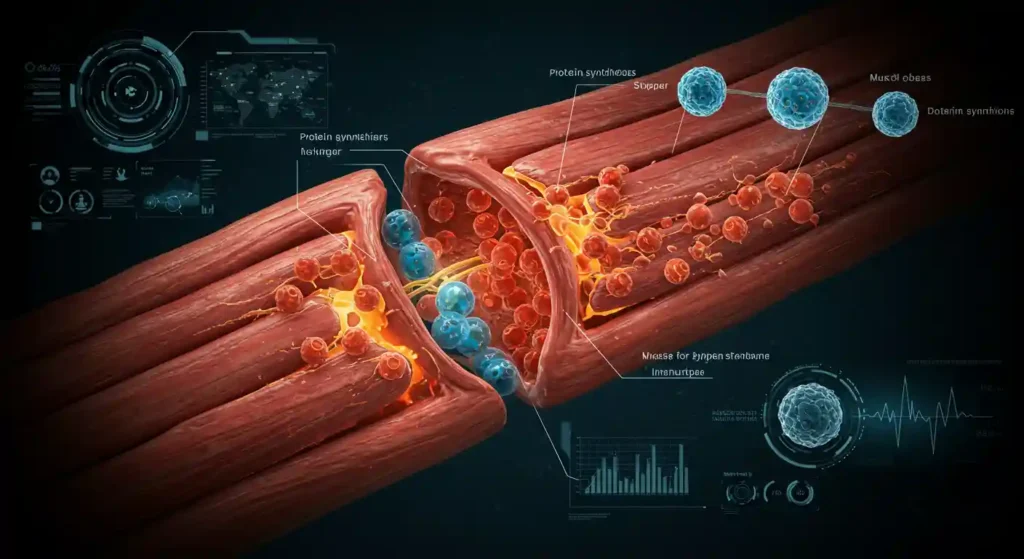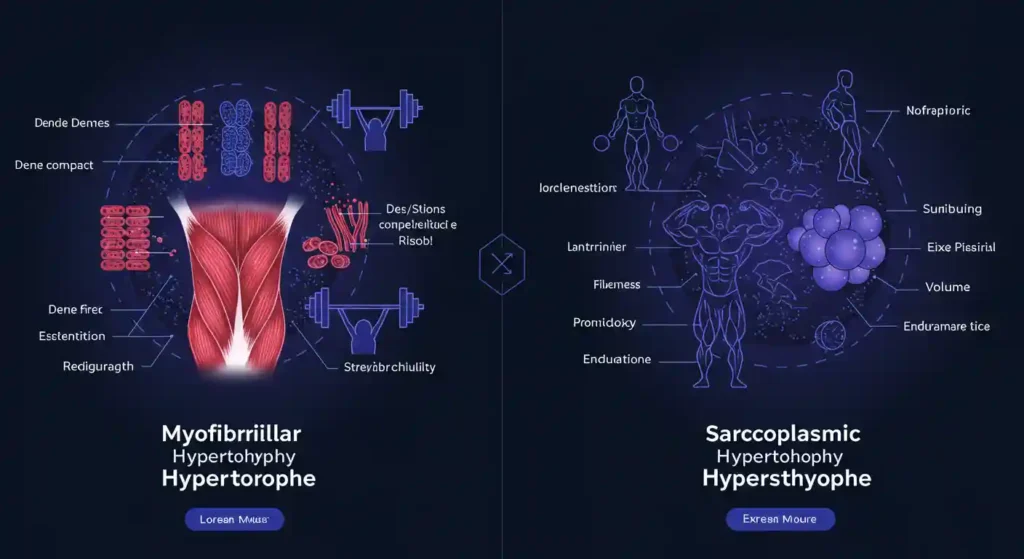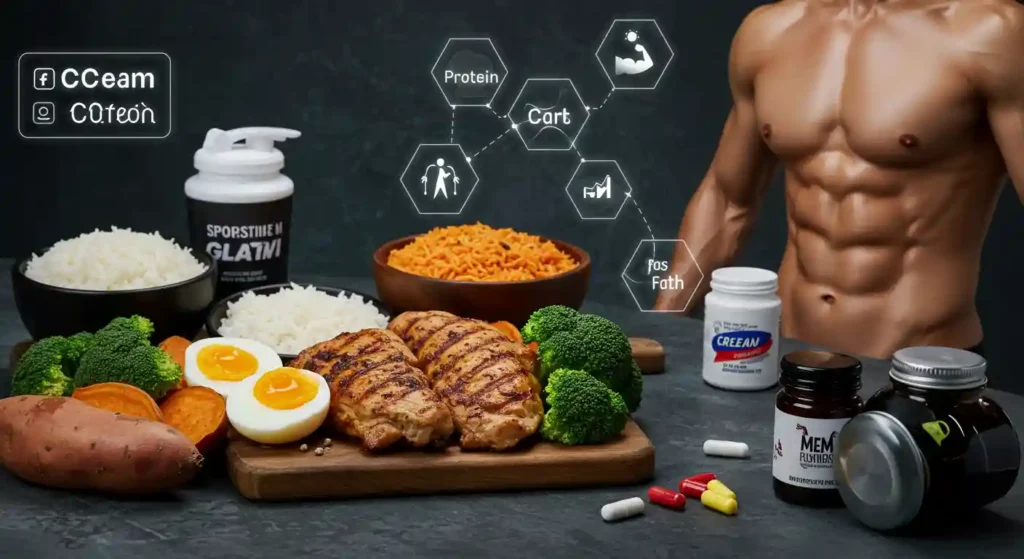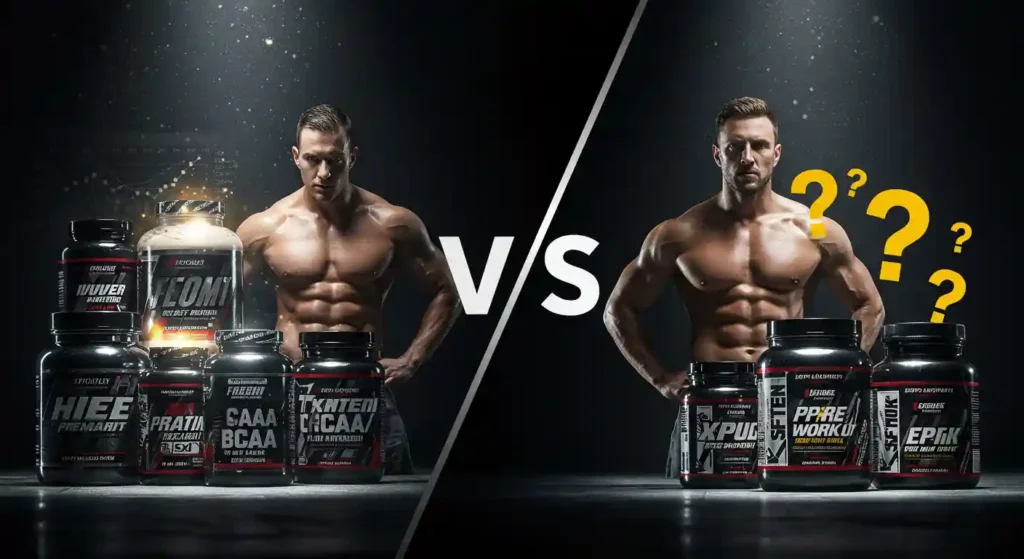
Muscle hypertrophy, or muscle growth, occurs through specific training and nutritional strategies. Key factors include applying mechanical tension, causing muscle damage, and inducing metabolic stress via resistance training. This stimulates muscle protein synthesis, leading to larger muscle fibers. Maximizing hypertrophy involves:
- Progressive Overload (consistently challenging muscles)
- Sufficient Training Volume & Intensity
- Adequate Protein Intake & Caloric Surplus
- Prioritizing Rest & Recovery (especially sleep)
Serious Muscle Hypertrophy
Did you know your muscles don’t actually grow during your workout, but primarily during the crucial rest periods after? It’s a common misconception, like thinking you need to obliterate yourself in every session to see results. The truth about building muscle is far more nuanced and fascinating. If you’re ready to move beyond guesswork and truly understand how to stimulate significant muscle hypertrophy, you’ve come to the right place.
As a certified personal trainer, I’ve guided countless individuals through their muscle-building journeys, and today, I’m laying out the complete roadmap for you. Forget the myths; let’s dive into the science and practical application of getting stronger and building the physique you desire through targeted muscle hypertrophy.
Table of Contents

What Exactly IS Muscle Hypertrophy?
Let’s get the terminology straight first. Muscle hypertrophy is simply the scientific term for the increase in the size of your muscle cells, which leads to an overall increase in the size of your muscles. Think of it as your muscles getting bigger and fuller.
But why should you care about muscle hypertrophy, beyond just aesthetics?
- Increased Strength & Performance: Bigger muscles generally mean stronger muscles. This translates to lifting heavier weights, improving athletic performance, and making everyday tasks easier.
- Boosted Metabolism: Muscle tissue is metabolically active. The more muscle mass you have, the more calories your body burns at rest (increased Basal Metabolic Rate – BMR). This is a huge advantage for long-term weight management.
- Improved Body Composition: Achieving muscle hypertrophy helps shift your body composition towards more lean mass and less fat mass, contributing to a healthier and more toned appearance.
- Enhanced Bone Health: Resistance training, the primary driver of hypertrophy, puts stress on your bones, signaling them to become denser and stronger, reducing the risk of osteoporosis.
- Better Insulin Sensitivity: Building muscle can improve your body’s ability to handle glucose, potentially reducing the risk of type 2 diabetes.
- Increased Longevity & Quality of Life: Studies link maintaining muscle mass, especially as we age (combating sarcopenia), with a longer, healthier, and more independent life.
So, pursuing muscle hypertrophy isn’t just about looking good (though that’s a nice perk!); it’s about building a stronger, healthier, more resilient version of yourself.

The Science: How Does Muscle Hypertrophy Happen?
Okay, let’s put on our lab coats for a minute (figuratively speaking!). Understanding the mechanisms behind muscle growth helps you train smarter. When you perform resistance exercise (like lifting weights), you essentially create a challenge that your muscles must adapt to. This adaptation process, leading to hypertrophy, is primarily driven by three key mechanisms:
➲ Mechanical Tension
This is arguably the most important factor. Mechanical tension refers to the force placed on your muscles during resistance exercise. When you lift a weight through a full range of motion, especially during the eccentric (lowering) phase, your muscle fibers experience significant tension. This tension disrupts the muscle cells’ structure and triggers signaling pathways that tell the muscle, “Hey, we need to get stronger and bigger to handle this stress next time!” Think of stretching a rubber band – that’s tension. Lifting challenging weights creates this tension within your muscle fibers.
- How to Maximize It: Lift weights that are challenging (typically in the 6-15 rep range), control the movement (especially the lowering phase), and aim for a full range of motion where possible.
➲ Muscle Damage
Ever feel sore after a tough workout (Delayed Onset Muscle Soreness or DOMS)? That’s partly due to microscopic tears or damage within the muscle fibers caused by the unaccustomed stress of training. Don’t worry, this isn’t necessarily a bad thing! This micro-damage initiates an inflammatory response and triggers satellite cells (muscle stem cells) to rush to the site. These satellite cells help repair the damaged fibers and fuse with existing ones, making them larger and more resilient.
- How to Induce (Appropriately): Introduce new exercises, increase training volume or intensity gradually, and focus on the eccentric phase of lifts. However, more damage isn’t always better. Excessive soreness can hinder recovery and subsequent workouts. Aim for manageable disruption, not annihilation.
➲ Metabolic Stress
Remember that “burn” or “pump” you feel during high-rep sets or when limiting rest periods? That’s metabolic stress. It occurs when energy production struggles to keep up with demand during intense exercise, leading to the accumulation of metabolic byproducts like lactate, hydrogen ions, and inorganic phosphate within the muscle cell.
This environment is thought to trigger muscle growth through various pathways, including cell swelling (the “pump,” which can stretch the cell wall) and hormonal responses.
- How to Increase It: Use moderate-to-high repetitions (e.g., 12-20+ reps), shorter rest periods (30-90 seconds), and techniques like drop sets or supersets. Bodybuilding-style training often emphasizes this mechanism.
The Interplay: It’s important to understand that these three mechanisms don’t work in isolation. A typical hypertrophy-focused workout will involve elements of all three. Heavy lifting emphasizes mechanical tension, while higher reps and shorter rests lean more towards metabolic stress. Both cause some degree of muscle damage. The optimal combination depends on your goals, training phase, and individual response.
➲ Role of Hormones
Your body’s hormones play a crucial supporting role in muscle hypertrophy. Think of them as the construction managers overseeing the building process triggered by training. Key players include:
- Testosterone: Often called the primary male sex hormone (though women produce it too, just in smaller amounts), testosterone plays a significant role in promoting muscle protein synthesis and inhibiting muscle protein breakdown.
- Growth Hormone (GH): Released by the pituitary gland, GH stimulates IGF-1 release and plays a role in tissue repair and growth. Its role in direct muscle hypertrophy is debated, but it certainly supports the overall anabolic environment.
- Insulin-like Growth Factor 1 (IGF-1): Influenced by GH and nutrition, IGF-1 is critical for activating satellite cells and promoting muscle protein synthesis.
- Insulin: While often associated with fat storage, insulin is also highly anabolic. It helps shuttle nutrients (like glucose and amino acids) into muscle cells and inhibits muscle breakdown.
Resistance training itself can acutely boost levels of these anabolic hormones, further supporting the growth process.
➲ Muscle Protein Synthesis (MPS) vs. Muscle Protein Breakdown (MPB)
At its core, muscle growth boils down to a simple equation: Muscle Hypertrophy = Muscle Protein Synthesis (MPS) > Muscle Protein Breakdown (MPB).
- MPS: The process of building new muscle proteins. Think of it as construction workers adding bricks to your muscle building. Resistance training and consuming adequate protein strongly stimulate MPS.
- MPB: The process of breaking down existing muscle proteins. This happens naturally throughout the day and is increased by factors like intense exercise (initially) and inadequate nutrition or rest.
Your goal with training, nutrition, and recovery is to consistently tip the balance in favor of MPS over extended periods. Resistance training provides the stimulus, protein provides the building blocks, and rest allows the construction to happen efficiently.

Types of Muscle Hypertrophy: More Than Just Size?
Did you know there are technically two types of hypertrophy that contribute to overall muscle size? Understanding the difference can help refine your training approach.
➲ Myofibrillar Hypertrophy
This refers to an increase in the number and size of the myofibrils within your muscle fibers. Myofibrils are the actual contractile proteins (actin and myosin) responsible for generating force.
- Result: Denser, stronger muscles. This type of hypertrophy is strongly correlated with increases in maximal strength.
- Training Emphasis: Typically stimulated more effectively by heavier weight training with lower repetitions (e.g., 3-8 reps) focusing on maximizing mechanical tension.
➲ Sarcoplasmic Hypertrophy
This involves an increase in the volume of the sarcoplasm, the fluid-filled space within the muscle cell that surrounds the myofibrils. This fluid contains glycogen (stored carbohydrates), water, minerals, and non-contractile proteins.
- Result: Increased muscle volume or “fullness,” often referred to as the “pump.” While it contributes to overall size, it may have less direct impact on maximal strength compared to myofibrillar hypertrophy.
- Training Emphasis: Often associated with higher repetition ranges (e.g., 10-20+ reps), shorter rest periods, and training methods that maximize metabolic stress and cell swelling. This is characteristic of much bodybuilding-style training.
The Reality: Most well-structured training programs will induce both types of hypertrophy to some degree. You can’t completely isolate one from the other.
However, by manipulating variables like rep ranges, loads, and rest periods, you can slightly emphasize one over the other depending on whether your primary goal is pure strength or maximal size/fullness. For most people seeking overall muscle hypertrophy, a blend incorporating different rep ranges is ideal.

Training Principles for Maximizing Muscle Hypertrophy
Knowing the science is great, but how do you apply it in the gym (or at home)? Let’s dive into the essential training principles:
➲ Progressive Overload: The Cornerstone
This is the single most important principle for long-term muscle hypertrophy. Progressive overload means continually challenging your muscles beyond what they are accustomed to. If you always lift the same weight for the same reps, your body adapts and has no reason to grow further. You MUST progressively increase the demand.
How to Apply:
- ➥Increase Weight: Lift slightly heavier loads for the same number of reps.
- ➥Increase Reps: Perform more repetitions with the same weight.
- ➥Increase Sets: Add more sets to your exercises.
- ➥Increase Frequency: Train muscle groups more often (within reason).
- ➥Decrease Rest Time: Shorten rest periods between sets (increases density and metabolic stress).
- ➥Improve Form/Tempo: Slow down the eccentric, pause at peak contraction (increases time under tension).
- ➥Increase Range of Motion: Improve flexibility to move through a greater range.
Key: Track your workouts! You can’t progressively overload if you don’t know what you did last time.
➲ Volume: How Much is Enough?
Training volume refers to the total amount of work performed, typically calculated as: Sets x Reps x Weight. Research suggests a dose-response relationship between volume and hypertrophy, meaning, up to a point, more volume generally leads to more growth.
- General Guideline: Aiming for 10-20 hard sets per muscle group per week seems to be a sweet spot for most individuals seeking hypertrophy.
- ➥Beginners might start closer to 10 sets.
- ➥Advanced trainees might push towards 20 or slightly more, carefully managing recovery.
- What’s a “Hard Set”? A set taken close to muscular failure, typically leaving 1-3 Reps In Reserve (RIR). You shouldn’t be able to do many more reps with good form.
- Distribution: Spread this volume across the week rather than doing it all in one session (see Frequency).
➲ Frequency: Hitting Muscles Effectively
Training frequency refers to how often you train a specific muscle group per week. The old-school “bro split” (training each muscle once a week) might not be optimal for maximizing hypertrophy for many natural lifters.
- Research Suggests: Training a muscle group 2-3 times per week generally leads to superior muscle hypertrophy compared to once per week, assuming total weekly volume is equated. This allows for more frequent stimulation of muscle protein synthesis.
- Practical Application: Full body workouts performed 3 times per week, or Upper/Lower splits performed 4 times per week, naturally accommodate this higher frequency.
➲ Intensity: Lifting Heavy vs. Moderate
Intensity in this context refers to the load lifted, usually expressed as a percentage of your one-rep max (1RM). While lifting heavy is crucial for strength (and contributes to myofibrillar hypertrophy), you don’t only need to lift super heavy for muscle growth.
| Rep Range | Range (Reps) | Focus | Recommendation |
|---|---|---|---|
| Heavy | 3-5 reps | Primarily builds strength, strong stimulus for myofibrillar hypertrophy. | Use for building raw strength and improving myofibrillar muscle growth. |
| Moderate | 6-15 reps | Considered the “hypertrophy sweet spot,” balances mechanical tension and metabolic stress. | Use as the main rep range for hypertrophy training. |
| Light | 15-30+ reps | Builds muscle through metabolic stress and fiber recruitment when close to failure. | Use for achieving the “burn” and focusing on muscle endurance, especially towards the end of a workout. |
➲ Rest Periods: Optimizing Recovery Between Sets
The time you rest between sets influences fatigue, metabolic stress, and the load you can lift in subsequent sets.
- Longer Rest (2-5 minutes): Generally better for heavy, compound exercises (squats, deadlifts, presses) where maximizing strength and mechanical tension is key. Allows for better recovery and lifting heavier loads on subsequent sets.
- Shorter Rest (30-90 seconds): Better for isolation exercises or when aiming to maximize metabolic stress and the “pump.” Limits recovery, leading to greater fatigue accumulation.
- Hybrid Approach: Use longer rests for your main compound lifts early in the workout, and potentially shorter rests for accessory/isolation work later on. Tailor it to the exercise and goal.
➲ Exercise Selection: Compound vs. Isolation
| Type of Exercise | Examples | Pros | Recommendation |
|---|---|---|---|
| Compound Exercises | Squats, Deadlifts, Bench Press, Overhead Press, Rows, Pull-ups | Highly efficient, allow for heavier loads (great for tension and overload), stimulate systemic hormonal responses, build functional strength. | These should form the foundation of any hypertrophy program. |
| Isolation Exercises | Bicep Curls, Triceps Extensions, Leg Extensions, Lateral Raises | Allow focused work on specific muscles, help bring up lagging body parts, useful for accumulating volume without excessive systemic fatigue, good for inducing metabolic stress. | Prioritize compound lifts, then add isolation exercises to target specific muscles and accumulate sufficient volume. |
➲ Tempo and Time Under Tension (TUT)
Tempo refers to the speed at which you perform each phase of a repetition. It’s often written as a sequence of numbers (e.g., 3-0-1-0):
- 3: Seconds for the eccentric (lowering) phase.
- 0: Seconds pause at the bottom.
- 1: Second for the concentric (lifting) phase.
- 0: Seconds pause at the top.
Time Under Tension (TUT) is the total time a muscle is under stress during a set. While deliberately slowing down reps can increase TUT and potentially metabolic stress/damage, focusing solely on TUT can sometimes lead to using lighter weights, potentially reducing mechanical tension.
- Practical Advice: Control the eccentric phase (don’t just drop the weight – aim for a 2-4 second negative). Lift the concentric phase powerfully but under control. Avoid excessive slowing unless using it strategically for specific exercises or goals. Don’t overcomplicate tempo; prioritize lifting challenging weights with good form through a full range of motion and controlling the negative.

Nutrition for Muscle Hypertrophy: Fueling the Growth
You can train as hard as you want, but without the right nutritional support, your potential for muscle hypertrophy will be severely limited. Think of training as the stimulus and nutrition as the building materials and energy source.
Mastering Macros for Muscle Gain: The Ultimate Guide to Fueling Your Growth
➲ Caloric Surplus: Eating to Grow
To build new muscle tissue, your body generally needs more energy (calories) than it burns. This is known as a caloric surplus. Trying to build significant muscle while in a steep calorie deficit (losing weight aggressively) is extremely difficult, especially for experienced lifters.
- Recommendation: Aim for a modest surplus – typically 250-500 calories above your maintenance level. This provides enough energy for growth without excessive fat gain.
- Finding Maintenance: Use online calculators as a starting point, then track your weight and adjust intake based on progress (if weight is stable, you’re at maintenance; slowly increase calories from there).
- Don’t “Dirty Bulk”: Eating everything in sight leads to unnecessary fat gain, which you’ll have to shed later. Focus on quality food sources in a controlled surplus.
➲ Protein Power: The Building Blocks
Protein provides the amino acids necessary for repairing damaged muscle tissue and synthesizing new proteins (MPS). It’s non-negotiable for muscle growth.
| Feature | Protein Intake | Timing | Sources |
|---|---|---|---|
| How Much? | 1.6 to 2.2 grams of protein per kilogram of body weight per day. | Distribute protein intake evenly across 3-5 meals/snacks. | Lean meats, fish, eggs, dairy, plant-based options (tofu, lentils, quinoa). |
| Example | For an 80kg (176lb) individual: 128g – 176g of protein daily. | At least 20-40g of protein per meal. | Whey/casein protein powders, soy, edamame, lentils, beans. |
| Fat Burning | Higher protein intake can help with fat mobilization and lean mass retention. | Protein helps in muscle maintenance during fat loss phases. | Complete protein sources (lean meats, fish, dairy). |
| Muscle Gain | Higher protein supports muscle growth, particularly when combined with resistance training. | Spread protein intake throughout the day to maximize muscle protein synthesis (MPS). | Plant-based options like quinoa, soy, beans, along with whey/casein. |
| Importance of Timing | Protein timing isn’t as critical as once thought but spreading intake is beneficial for MPS. | Post-workout protein intake still beneficial, but overall daily intake is key. | Prioritize high-quality, complete protein sources. |
➲ Carbohydrates: Energy & Recovery
Carbohydrates are your body’s primary fuel source, especially during intense training. They also play a crucial role in recovery and muscle growth.
- Fueling Workouts: Adequate carb intake ensures your glycogen stores are full, allowing you to train harder and longer.
- Replenishing Glycogen: Post-workout carbs help replenish depleted muscle glycogen stores, aiding recovery.
- Insulin Response: Carbs stimulate insulin release, which, as mentioned, is anabolic and helps drive nutrients into muscle cells.
- Recommendation: The amount varies based on individual needs, activity level, and preference, but generally, 3-6 grams of carbs per kilogram of body weight (1.4-2.7g/lb) is a good starting point for hypertrophy goals. Adjust based on energy levels and performance.
- Sources: Focus on complex carbohydrates like oats, brown rice, quinoa, potatoes, sweet potatoes, whole-grain bread/pasta, fruits, and vegetables for sustained energy. Simpler carbs can be useful around workout times.
➲ Healthy Fats: Hormone Support
Dietary fats are essential for overall health and play a vital role in producing anabolic hormones like testosterone. Don’t shy away from them!
- Recommendation: Aim for 20-35% of your total daily calories from fats.
- Sources: Prioritize unsaturated fats found in avocados, nuts, seeds (chia, flax, hemp), olive oil, and fatty fish (salmon, mackerel). Limit excessive saturated and trans fats.
➲ Hydration: Often Overlooked
Dehydration can significantly impair performance, recovery, and even muscle function. Water is involved in nearly every metabolic process, including nutrient transport and waste removal.
- Recommendation: Aim for at least 3-4 liters (about 0.8-1 gallon) of water per day, potentially more depending on your size, climate, and activity level. Monitor urine color (aim for pale yellow). Don’t wait until you’re thirsty.

Supplements: Aids or Hype?
Supplements can supplement a good diet and training plan, but they cannot replace them. Focus on nailing the basics first. However, a few have strong evidence supporting their use for muscle hypertrophy:
- Creatine Monohydrate: The most studied and effective supplement for increasing strength, power output, and muscle mass. It helps replenish ATP (energy) stores quickly during high-intensity bursts. Aim for 3-5g per day. [Internal Link Suggestion: Link to detailed Creatine article]
- Protein Powders (Whey, Casein, Soy, Blends): Convenient way to increase daily protein intake, especially around workouts or if struggling to meet needs through whole foods.
- Caffeine: Effective pre-workout stimulant that can improve performance, reduce perceived exertion, and allow you to train harder. Be mindful of tolerance and timing (avoid close to bedtime).
- Beta-Alanine: Can buffer acid buildup in muscles during high-intensity exercise lasting 1-4 minutes, potentially allowing for more reps and volume. Causes a harmless tingling sensation (paresthesia).
- Citrulline Malate: May improve blood flow (pump), reduce fatigue, and enhance recovery.
Buyer Beware: The supplement industry is vast and often overhyped. Stick to supplements with robust scientific backing. Be skeptical of miracle claims. [External Link Suggestion: Link to Examine.com for unbiased supplement research]
Recovery & Rest: The Unsung Hero of Muscle Hypertrophy
You stimulate growth in the gym, you fuel it in the kitchen, but the actual building of muscle happens during recovery. Neglect this, and you sabotage your progress.
➲ Sleep: Your Body’s Repair Shop
Sleep is arguably the most critical recovery tool. During deep sleep cycles, your body releases Growth Hormone, repairs tissues (including muscle), consolidates memories (motor learning), and manages stress hormones like cortisol.
- Recommendation: Aim for 7-9 hours of quality sleep per night. Consistency is key.
- Tips for Better Sleep: Maintain a regular sleep schedule, create a dark, cool, quiet sleep environment, avoid caffeine and large meals late at night, limit blue light exposure before bed. [Internal Link Suggestion: Link to Sleep Hygiene article]
➲ Active Recovery & Deload Weeks
- Active Recovery: Low-intensity activities like walking, light cycling, stretching, or foam rolling on rest days can promote blood flow, potentially reduce soreness, and aid recovery without adding significant stress.
- Deload Weeks: Periodically (e.g., every 4-12 weeks), incorporating a deload week where you significantly reduce training volume and/or intensity can help dissipate accumulated fatigue, prevent burnout, reduce injury risk, and allow your body to fully recover and resensitize to training stimuli. This is crucial for long-term, sustainable muscle hypertrophy.
➲ Stress Management
Chronic stress elevates cortisol levels. While cortisol has essential functions, chronically high levels can be catabolic (promote muscle breakdown), impair recovery, interfere with sleep, and encourage fat storage.
- Strategies: Find healthy ways to manage stress, such as meditation, deep breathing exercises, yoga, spending time in nature, hobbies, or talking to someone. Prioritize mental well-being alongside physical training.
Putting It All Together: Sample Muscle Hypertrophy Training Splits
How do you organize your training week to hit all the principles? Here are a few popular and effective training splits:
➲ Full Body Workouts
| Structure | Details |
|---|---|
| Frequency | Train all major muscle groups in each session. Typically performed 3 days per week (e.g., Mon/Wed/Fri) with rest days in between. |
| Pros | High frequency (each muscle hit 3x/week), great for beginners, time-efficient, allows for good recovery between sessions. |
| Cons | Sessions can become long if including many exercises, might be harder to focus intensely on specific body parts. |
| Example Session | Squats (3 sets), Bench Press (3 sets), Barbell Rows (3 sets), Overhead Press (2 sets), Romanian Deadlifts (2 sets), Bicep Curls (2 sets), Triceps Pushdowns (2 sets). |
➲ Upper/Lower Split
| Structure | Details |
|---|---|
| Frequency | Alternate between upper body focused days and lower body focused days. Typically performed 4 days per week (e.g., Mon-Upper, Tue-Lower, Wed-Rest, Thu-Upper, Fri-Lower). |
| Pros | Each muscle group hit 2x/week, allows for more volume per muscle group per session compared to full body, good balance of frequency and recovery. |
| Cons | Requires 4 training days per week, slightly less frequency than full body. |
| Example Upper Day | Bench Press, Rows, Overhead Press, Pull-downs/Pull-ups, Lateral Raises, Bicep Curls, Triceps Extensions. |
| Example Lower Day | Squats, Deadlifts (or variation), Leg Press, Hamstring Curls, Calf Raises, Ab work. |
➲ Push/Pull/Legs (PPL) Split
| Structure | Details |
|---|---|
| Frequency | Days dedicated to Pushing movements (Chest, Shoulders, Triceps), Pulling movements (Back, Biceps), and Legs. Typically run twice over a 6-day cycle (PPLRPPLR… R=Rest) or once over 3 days with more rest. |
| Pros | Each muscle group hit 2x/week (if run twice), allows for high focus and volume per muscle group, synergistic muscle groupings. Very popular for hypertrophy. |
| Cons | Requires 5-6 training days per week for higher frequency, can be demanding. |
| Example Push Day | Bench Press, Overhead Press, Incline Dumbbell Press, Lateral Raises, Triceps Pushdowns. |
| Example Pull Day | Pull-ups/Lat Pulldowns, Barbell Rows, Face Pulls, Bicep Curls, Hammer Curls. |
| Example Leg Day | Squats, Romanian Deadlifts, Leg Press, Leg Curls, Calf Raises. |
➲ Body Part Splits (“Bro Split”)
| Structure | Details |
|---|---|
| Frequency | Dedicate each training day to one or two specific body parts (e.g., Monday-Chest, Tuesday-Back, Wednesday-Legs, Thursday-Shoulders, Friday-Arms). |
| Pros | Allows maximum focus and volume on a specific muscle group in one session, can be enjoyable (“pump chasing”). |
| Cons | Lower frequency (each muscle hit only 1x/week), research suggests this may be suboptimal for muscle hypertrophy compared to higher frequencies for natural trainees. May require longer sessions. |
| Consideration | While potentially less optimal, it can still work if volume and intensity are sufficient, and some people simply prefer this style. |
Which split is best? The one you can consistently stick to and recover from! Consider your schedule, recovery capacity, and preferences. For most people aiming to maximize hypertrophy, splits allowing 2-3x weekly frequency per muscle (Full Body, Upper/Lower, PPL) tend to be more effective.

Measuring Progress & Adjusting Your Plan
How do you know if your muscle hypertrophy plan is actually working? You need to track your progress.
➲ Tracking Workouts
- What: Log your exercises, sets, reps, and weight lifted for every session. Use a notebook, app, or spreadsheet.
- Why: Essential for ensuring progressive overload. You need to know what you did last time to beat it next time.
➲ Taking Measurements & Photos
- What: Use a tape measure to track circumference changes (arms, chest, waist, thighs) every 4-8 weeks. Take progress photos in consistent lighting and poses.
- Why: The scale doesn’t tell the whole story. Muscle is denser than fat, so you might gain muscle and lose fat without much change in scale weight. Measurements and photos provide visual evidence of body composition changes.
➲ Listening to Your Body
- What: Pay attention to energy levels, sleep quality, motivation, aches, and pains.
- Why: Overtraining can manifest as persistent fatigue, poor sleep, decreased performance, and nagging injuries. Don’t push through significant pain. Learn the difference between muscle soreness and joint pain.
➲ Knowing When to Change Things Up
- Plateaus: If your strength gains and measurements stall for several weeks despite consistent effort and overload attempts, it might be time for a change.
- What to Change (Don’t change everything at once!):
- ➥Introduce new exercises or variations.
- ➥Adjust rep ranges (e.g., switch from 8-12 reps to 5-8 reps for a phase).
- ➥Modify your training split.
- ➥Implement a deload week.
- ➥Re-evaluate your nutrition and recovery.

Common Mistakes Sabotaging Your Muscle Hypertrophy Goals
➲ Poor Form / Ego Lifting
Lifting too much weight with sloppy form increases injury risk and decreases the tension on the target muscle. Check your ego at the door, lighten the load if necessary, and focus on quality movement through a full range of motion. Master the technique before piling on weight.
➲ Inconsistent Training / Diet
Skipping workouts frequently or being haphazard with your nutrition will kill your gains. Muscle hypertrophy requires consistent stimulus and fuel. Aim for at least 80-90% adherence to your plan week after week. Consistency trumps perfection.
➲ Ignoring Recovery (Especially Sleep)
Thinking more training is always better is a trap. Overtraining by neglecting rest days, deloads, and especially sleep will halt progress and potentially lead to burnout or injury. Prioritize your 7-9 hours!
➲ Program Hopping
Constantly switching programs every few weeks doesn’t allow your body enough time to adapt and progress. Stick with a well-structured program for at least 8-12 weeks (or longer if you’re still progressing) before considering major changes. Give the process time.
➲ Not Eating Enough (Especially Protein & Calories)
Fear of gaining fat often leads people (especially beginners or those transitioning from weight loss) to undereat. You need building blocks (protein) and energy (calories) to construct new muscle. Ensure you’re in a modest surplus with adequate protein intake.

Muscle Hypertrophy for Specific Populations
While the core principles remain the same, some considerations apply:
➲ Beginners
- Focus: Master basic compound movements with good form.
- Volume/Intensity: Start on the lower end (e.g., ~10 sets/muscle/week) and focus on learning technique rather than lifting to absolute failure initially.
- Progress: Beginners often experience rapid initial gains (“newbie gains”) due to neural adaptations and muscle growth. Enjoy it, but stay consistent! Full-body routines 3x/week are often ideal.
➲ Women
- Myth Busting: Women can and should train for muscle hypertrophy! Concerns about getting “bulky” are largely unfounded due to hormonal differences (significantly less testosterone than men). Building muscle creates a strong, toned physique, not excessive bulk.
- Training: Principles are the same as for men – progressive overload, sufficient volume/intensity, compound lifts.
- Benefits: All the same health and performance benefits apply, plus potentially helping with hormonal balance and bone density (crucial post-menopause). [Internal Link Suggestion: Link to “Weight Training for Women” article]
➲ Older Adults
- Sarcopenia: Muscle loss with age is common but not inevitable. Resistance training is the most effective way to combat sarcopenia and maintain functional independence.
- Focus: Prioritize safety, proper form, and gradual progression. Compound exercises that mimic daily movements (squats, presses, rows) are excellent.
- Recovery: May require slightly more recovery time between sessions. Listen to your body.
- Benefits: Improved strength, balance, bone density, metabolic health, and overall quality of life. It’s never too late to start building muscle!

Conclusion: Your Journey to Muscle Hypertrophy Starts Now
We’ve covered a lot, from the nitty-gritty science of how muscles grow to the practical application of training, nutrition, and recovery strategies needed to achieve significant muscle hypertrophy.
Remember the key takeaways:
- Muscle hypertrophy is the increase in muscle cell size, driven by mechanical tension, muscle damage, and metabolic stress from resistance training.
- Progressive overload is non-negotiable – consistently challenge your muscles.
- Train with sufficient volume (10-20 sets/muscle/week) and frequency (hitting muscles 2-3x/week is often optimal).
- Incorporate a variety of rep ranges and prioritize compound exercises.
- Fuel growth with a modest caloric surplus and adequate protein (1.6-2.2g/kg).
- Never underestimate the power of sleep and recovery.
- Be consistent, track your progress, and avoid common pitfalls.
Building muscle is a marathon, not a sprint. It takes dedication, patience, and smart work. But the rewards – increased strength, improved health, boosted metabolism, enhanced confidence, and a more capable body – are absolutely worth the effort. You now have the knowledge and the blueprint. The next step is action. Embrace the process, stay consistent, and witness the incredible power of muscle hypertrophy transform your body and your life.
What’s your biggest takeaway from this guide? Do you have any questions about starting your own muscle hypertrophy journey? Share your thoughts in the comments below – I love hearing from you and helping you reach your goals!
(Optional CTA): Ready to put this into practice? Download our FREE Beginner’s Hypertrophy Workout Plan [Link Placeholder] and take the first step today!
FAQs About Muscle Hypertrophy
Here are some common questions I get asked about building muscle:
1. Is this guide suitable for complete beginners?
Absolutely! While we covered advanced concepts, the core principles (progressive overload, compound lifts, nutrition basics, recovery) are universal. Beginners should focus on mastering form with lighter weights on compound exercises, perhaps starting with a full-body routine 2-3 times per week, and gradually increasing volume and intensity as they get stronger and more comfortable. Consistency is key for beginners.
2. What if I can’t train 4-6 times per week like some splits suggest?
That’s perfectly fine! Significant muscle hypertrophy can still be achieved training just 2-3 times per week. A full-body routine performed 3 times per week hits each muscle group with optimal frequency. Even 2 well-structured full-body sessions per week can yield results, especially for beginners or those with limited time. The best frequency is the one you can consistently adhere to long-term.
3. How fast will I see results from focusing on muscle hypertrophy?
Results vary based on genetics, training consistency, diet adherence, sleep quality, and training experience. Beginners often see noticeable strength gains within weeks (due to neural adaptations) and visible muscle changes within 1-3 months. More experienced lifters will see slower progress. Be patient! Track measurements and photos over months, not just days or weeks, to see tangible changes. Focus on consistent effort and celebrating performance improvements (lifting heavier, more reps).
4. What’s the difference between training purely for strength versus muscle hypertrophy?
While related (bigger muscles are generally stronger), the training emphasis differs slightly.
- Strength Focus: Primarily uses very heavy weights (85%+ of 1RM) for low reps (1-5), longer rest periods, focusing on maximizing neural efficiency and myofibrillar hypertrophy. Volume might be lower.
- Hypertrophy Focus: Uses a wider range of reps (often 6-15+, sometimes lighter), moderate-to-shorter rest periods, aiming for a balance of mechanical tension and metabolic stress to maximize overall muscle size (both myofibrillar and sarcoplasmic). Volume is typically higher.
- Overlap: Strength training builds muscle, and hypertrophy training builds strength. Many programs blend elements of both.
5. Does cardio interfere with muscle hypertrophy?
Excessive amounts of high-intensity or very long-duration cardio can potentially interfere with recovery and muscle growth signaling pathways (the “interference effect”), especially if performed immediately before or after resistance training or if overall calorie intake isn’t sufficient. However, moderate amounts of cardio (e.g., 2-3 sessions of 20-40 minutes per week) are generally beneficial for overall health and shouldn’t significantly hinder muscle hypertrophy, provided your nutrition and recovery are adequate. Prioritize resistance training if hypertrophy is your main goal. Schedule cardio on separate days or several hours apart from lifting if possible.




